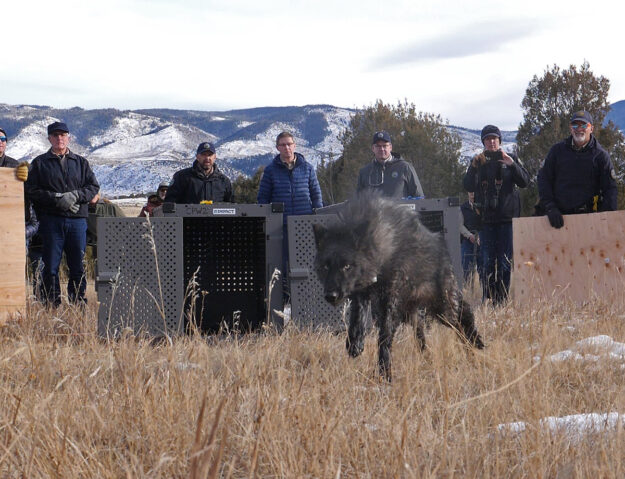Widgetized Section
Go to Admin » Appearance » Widgets » and move Gabfire Widget: Social into that MastheadOverlay zone
Colorado releases 5 wolves on public lands in neighboring Grand County

Colorado Parks and Wildlife officials release 1 of 5 gray wolves onto public land in Grand County, Dec. 18, 2023 (courtesy of Colorado Parks and Wildlife).
Five gray wolves captured by Colorado wildlife agents in Oregon were released into the wild on the Western Slope on Monday, fulfilling a voter-approved 2020 ballot initiative to reintroduce the animals in Colorado in the name of restoring ecological balance.
Video footage released by Colorado Parks and Wildlife showed Gov. Jared Polis and Reid DeWalt, CPW’s assistant director for aquatic, terrestrial and natural resources, releasing two of the wolves from their crates on at an undisclosed location in Grand County.
“Today, history was made in Colorado,” Polis said in a written statement. “For the first time since the 1940s, the howl of wolves will officially return to western Colorado.”
“I am proud of the Colorado Parks and Wildlife staff for their hard work to make this happen,” Polis added. “The shared efforts to reintroduce wolves are just getting started and wolves will rejoin a diverse ecosystem of Colorado wildlife.”
Colorado voters approved Proposition 114, the wolf reintroduction ballot measure, by a narrow 51% to 49% margin in 2020, beginning three years of planning, debate and controversy in the lead-up to Monday’s releases. A last-minute lawsuit filed by the cattle industry sought to delay reintroduction but was rejected by a judge on Friday, while a special Endangered Species Act exemption finalized by federal officials this month, which will allow for the killing and harassment of certain wolves deemed a threat to livestock, has been criticized by environmentalists as too broad.
“Pulling off a successful first wolf release in Colorado touched all corners of our agency,” DeWalt said in a statement. “This has been two years of work to approve the plan plus another year of work to secure our first source population and get us to this release day.”
Though gray wolves are native to Colorado and other Rocky Mountain states, they were hunted to near-extinction by settlers and ranchers in the late 19th and early 20th centuries. With the support of conservation groups, reintroduction efforts like one in Yellowstone National Park beginning in 1995 have allowed populations to recover in the northern Rockies. Studies have linked wolf reintroduction to a variety of positive effects on impacted ecosystems, like healthier elk herds and the recovery of riparian habitats previously damaged by over-grazing.
Although federal data shows that wolf predation only accounts for a fraction of a percent of livestock mortality in states where wolves are present, reintroduction has proved highly controversial among ranchers and on the Western Slope generally, where voters in all but a handful of counties opposed Proposition 114. The new law mandates compensation to livestock producers for confirmed losses due to predation.
Colorado reached an agreement with Oregon to source up to 10 wolves this winter after officials in states including Wyoming, Montana and Idaho — where ranching and hunting interests have also fueled a conservative backlash to wolf reintroduction programs begun in the 1990s — pointedly declined to assist Colorado’s efforts. CPW officials also hope to source wolves from Washington later this winter.
The first five wolves — two juvenile females, two juvenile males and an adult male — were captured from three different packs in northeastern Oregon on Sunday, according to a CPW press release, and were given health evaluations, vaccines and outfitted with GPS tracking collars before being flown to Colorado.
The agency’s reintroduction plan, finalized earlier this year, calls for the release of 10 to 15 wolves per year over the next three to five years, with an initial target of a stable population of at least 50 animals within the state. Under the plan, any state protections for wolves would expire once the population reaches 200 animals, potentially leading to legal wolf hunting, which states like Montana and Wyoming have allowed to the dismay of environmentalists.
Conservation advocates have also expressed concerns about the so-called 10(j) rule granted to the state by the U.S. Fish and Wildlife Service. Named for a section in the Endangered Species Act, the 10(j) exemption designates Colorado’s wolf herds as “experimental populations,” authorizing lethal control, as well as “injurious nonlethal” methods and “intentional harassment,” against wolves who threaten livestock.
But the Polis administration says the rule is a key element in its plan to reduce conflicts between wolves and humans as it manages the reintroduction process in the years to come.
“Having the rule in place in early December helped CPW to stay on track to reintroduce wolves in 2023 with the ability to use the appropriate management tools,” CPW Director Jeff Davis. “We’ll continue releasing animals based on our plan to have wolves not just survive but thrive in Colorado as they did a century ago.”
Editor’s note: This story first appeared on Colorado Newsline, which is part of States Newsroom, a network of news bureaus supported by grants and a coalition of donors as a 501c(3) public charity. Colorado Newsline maintains editorial independence. Contact Editor Quentin Young for questions: info@coloradonewsline.com. Follow Colorado Newsline on Facebook and Twitter.
Chase Woodruff
Latest posts by Chase Woodruff (see all)
- Evans, Boebert defend Medicaid cuts as protesters shout them down in Denver - May 30, 2025
- Colorado officials envision Mountain Rail by 2026, Denver to Boulder to Fort Collins by 2029 - May 19, 2025
- Colorado’s Evans votes in favor of bill that will kick at least 7.6 million people off Medicaid coverage - May 15, 2025


